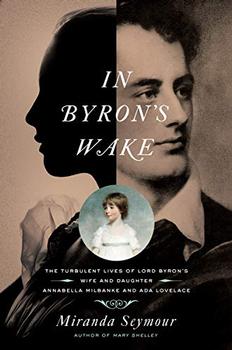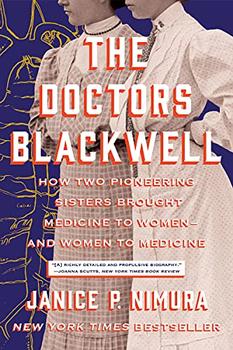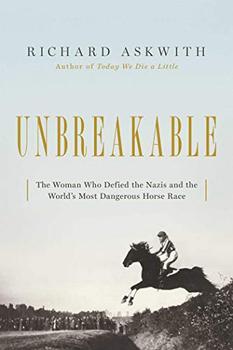Summary | Excerpt | Reviews | Beyond the book | Read-Alikes | Genres & Themes | Author Bio
The Turbulent Lives of Lord Byron's Wife and Daughter: Annabella Milbanke and Ada Lovelace

Critics' Opinion:
Readers' Opinion:
First Published:
Nov 2018, 560 pages
Paperback:
Nov 2020, 568 pages
 Book Reviewed by:
Book Reviewed by:
Rose Rankin
Buy This Book
It's tempting to think that our age of celebrity worship coupled with the 24-hour news cycle is responsible for the double standard around men's abusive behavior towards women. The perpetrators' reputations are often rehabilitated; they go on to become box office film stars or government officials, while the women they have abused are harassed and slandered. The widespread rage surrounding this cultural norm has been a driving factor in the #MeToo movement.
And yet, this situation is nothing new — as long as there have been famous men acting badly, there have been apologists for them and impossible standards to which their female victims are held. Miranda Seymour's In Byron's Wake shines a light on this aspect of celebrity through the biographies of Lord Byron's wife, Annabella Milbanke, and their daughter, Ada Lovelace, who both spent their lives with his shadow hanging over them. Though there are a few organizational flaws, this book reveals fascinating details about the painful legacy of a disastrous relationship and how these two women chose to define themselves in spite of, or because of it.
Annabella was a beloved only child, fêted debutante of English aristocratic society, and headstrong young woman who rejected numerous suitors in order to pursue Lord Byron. When he met her in 1812, the poet was already famous for his writing and infamous for his romantic involvements, frequently with married women. A long-distance courtship was conducted mostly through letters, until a reluctant Lord Byron agreed to marry Annabella, primarily since doing so would deflect attention from his suspicious relationship with his half-sister, Augusta Leigh, and Annabella's expected inheritance would assuage his financial problems.
It all fell apart quickly and spectacularly. The inheritance went to Annabella's mother, Byron continued his incestuous relationship, taunting Annabella with his affection for Augusta, who lived with them for much of their one-year marriage. Constantly threatening her with violence and getting involved with more mistresses, Byron made Annabella miserable until 1816 when she finally fled their home with their newborn daughter, Ada. The couple's separation became fodder for the press and Victorian society was scandalized.
Seymour tells the tale through their voluminous letter collections, allowing the reader to hear the unhappy couple in their own words. This meticulous archival research shows the sadness and even terror of an abusive relationship, without melodrama or rose-colored glasses. The account is grounded in historical data, not delivered in the bated-breath tone of celebrity gossip.
Byron soon left for continental Europe, never to return to England. Later that year he would be living on Lake Geneva with Percy and Mary Shelley while the latter was writing Frankenstein (see Beyond the Book). Byron had a string of lovers and mingled with writers and revolutionaries before dying at age 36 while fighting in the Greek War of Independence, while Annabella became a model of chastity and an ardent social reformer, remaining stoic in the face of whispers and rumors that followed her for the rest of her life. In an age when women were often criticized for being vocal, Lady Byron was scorned for her silence surrounding her marriage. In fact, her work as a dedicated abolitionist and education reformer became subsumed by her reputation as a cruel wife to the creative genius Byron.
After the drama of the marriage, the book focuses on the life of Ada Lovelace, the bright yet mercurial product of the union. A voracious learner, Ada was educated by tutors and mentors while overcoming serious health problems as a child. She became a fixture of scientific-minded circles, collaborating frequently with computer-science pioneer Charles Babbage. Ada's greatest work was an extended report on the intended capabilities of Babbage's Analytical Engine, a remarkable idea for a machine that could carry out numerous complex calculations, an early precursor to the computer. Anticipating punch cards and computer code itself, Ada's report on the Analytical Machine is now recognized as foreseeing the modern computing age — how these machines would move beyond mathematics. She saw, as Seymour notes, "the potential of technology to transform the way we function."
For an achievement that impressive, however, the author takes too much time getting to it. Ada's contribution to scientific knowledge is not described in any detail through the first half of the book, despite Seymour cataloging every country house she visited and every correspondence she shared. The reader would be better served by a deeper discussion of Ada's place in the developing world of science and the role of women (or lack thereof) in that world, rather than getting bogged down in minute details about her every movement between her mother's many estates. Despite this small defect, the book captures many important aspects of Ada's life without becoming hagiography. Ada's later years were marred by her own dysfunctional marriage and her involvement in an illegal gambling ring. It was only her mother's shrewd business acumen and vast fortune that kept her and her spendthrift husband from poverty.
Like her father, Ada died young, at age 36. Stricken with cervical cancer, she became too ill to pursue more scientific research or the mathematics that had always fascinated her. Annabella died eight years later in 1860, and both women's reputations evolved following their deaths. Lady Byron was decried as a cold and silent woman who drove her husband away, while Ada Lovelace went from being known as a bright yet eccentric minor aristocrat to being hailed as an early computer scientist. As Seymour demonstrates, both characterizations are oversimplified, and the women behind them were more three-dimensional than their reputations suggest. While the man who most impacted their lives remains a celebrity, their legacies — both built around their relationship to him — have always been more complex and nuanced than their detractors, or their fans, believed.
![]() This review was originally published in The BookBrowse Review in January 2019, and has been updated for the
November 2020 edition.
Click here to go to this issue.
This review was originally published in The BookBrowse Review in January 2019, and has been updated for the
November 2020 edition.
Click here to go to this issue.

If you liked In Byron's Wake, try these:

by Janice P. Nimura
Published 2022
Elizabeth Blackwell believed from an early age that she was destined for a mission beyond the scope of "ordinary" womanhood.

by Richard Askwith
Published 2021
The courageous and heartbreaking story of a Czech countess who defied the Nazis in a legendary horse race.





The House on Biscayne Bay
by Chanel Cleeton
As death stalks a gothic mansion in Miami, the lives of two women intertwine as the past and present collide.

The Flower Sisters
by Michelle Collins Anderson
From the new Fannie Flagg of the Ozarks, a richly-woven story of family, forgiveness, and reinvention.

The Funeral Cryer by Wenyan Lu
Debut novelist Wenyan Lu brings us this witty yet profound story about one woman's midlife reawakening in contemporary rural China.
Your guide toexceptional books
BookBrowse seeks out and recommends the best in contemporary fiction and nonfiction—books that not only engage and entertain but also deepen our understanding of ourselves and the world around us.